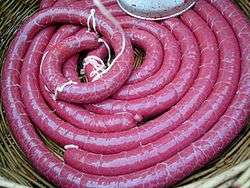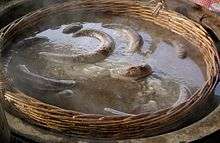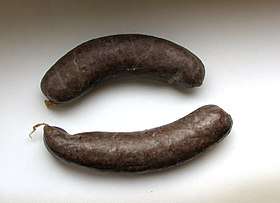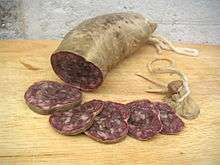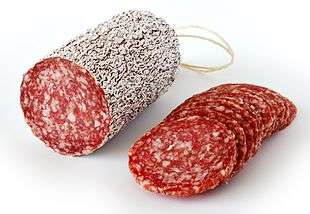Blood sausage
Blood sausages are sausages filled with blood that is cooked or dried and mixed with a filler until it is thick enough to solidify when cooled. Variants are found worldwide. Pig, cow, horse, donkey, sheep, duck, and goat blood can be used, varying by country. For the distinct regional type of blood sausage originating in the United Kingdom and Ireland see black pudding, also sometimes called blood pudding[1][2]
In Europe and the Americas, typical fillers include meat, fat, suet, bread, cornmeal, onion, chestnuts, barley, oatmeal and buckwheat. On the Iberian Peninsula and in Asia, rice is often used instead of other cereals. Sweet variants with sugar, honey, orange peel and spices are also regional specialties.
In many languages, there is a general term such as blood sausage (American English) and blood pudding (British English) that is used for all sausages that are made from blood, whether or not they include non-animal material such as bread, cereal, and nuts. Sausages that include such material are often, in addition, referred to with more specific terms, for example, black pudding in English.[3]
Africa
In Kenya mutura is a traditional dish among the people of central Kenya, although today popular among all. It is made with meat, blood, and spices all encased in the animal's intestines or stomach.[4] In Kenya fillers include fresh minced goat or beef, fat, and red onions.
The slaughtered goat, cow or sheep has its blood collected to use in the stuffing, though today many types of mutura, especially commercial ones sold on the streets, do not contain blood. The meat for the filling can be any fleshy part, but like any other sausage, the prime cuts are not ordinarily used for the stuffing. Instead the tougher, leaner cuts — for example the neck — are trimmed off the bone. The casing for the stuffing is the stomach sac and larger intestines. These are flushed many times with water to clean them.
The meat for the stuffing is finely chopped or minced, and the mandatory fat is often trimmed from other parts. The meat is slightly fried, mixed with finely chopped red onions, salt and optionally fresh chili. Other additions include freshly chopped coriander (dhania or cilantro), garlic, pepper and even beef stock. This is then mixed thoroughly with the fresh blood from the animal, and stuffed into the stomach and intestines, with the openings sewn or tied together with string.
The sausage is boiled in a large pot (often with other parts of the animal not roasted and used to make soup) for 30-45 minutes, and roasted over coals till brown. Sliced, it is served with kachumbari, an onion based salad consisting of tomatoes, red onions and fresh coriander, a bit of chili and squeeze of lemon. The accompanying starch is ugali.
Americas
United States
Blood sausages are very difficult to find in US supermarkets. Brussels and Sturgeon Bay, Wisconsin are both home to local grocers who produce blood sausage, due to their large Belgian American populations. Supermarkets throughout Maine also carry locally produced blood pudding due to the state's large French Canadian population. In southeastern Michigan, Polish-style kaszanka can be found in supermarkets throughout the year and is very popular.
An Italian-American version of blood sausage in the San Francisco Bay Area is called biroldo and has pine nuts, raisins, spices, and pig snouts and is made using either pig's or cow's blood. German-style blood sausage and Zungenwurst can be found in Fresno and Santa Rosa, where Russian and Armenian delis offer a wide range of Central European foods. Also, Alpine Village in Torrance, California has Blutwurst due to a considerable German-American population in the South Bay area of Los Angeles County.
Cajun boudin is a fresh sausage made with green onions, pork, pork liver (making it somewhat gritty or grainy), and rice. Pig's blood was sometimes added to produce boudin rouge, but this tradition became increasingly rare after the mid-twentieth century due to the decline of the boucherie (traditional communal butchering) and government health regulations prohibiting the transportation of raw blood. As a result, Cajun boudin is now usually made without blood; however, blood or "black" boudin can still be purchased.
Latin America
In many areas of Latin America, morcilla is served. Morcilla is sometimes made with a filler of rice and/or onions, and seasoned with paprika and other spices. In Puerto Rico, it is served fried and mostly consumed during the holidays. In Colombia, morcilla can have rice, green peas, cilantro or culantro, and is often eaten as an appetizer called "picada" or with the traditional dishes "Bandeja Paisa" or "Fritanga". In Venezuela, morcilla is often served with parrilla (barbecue).
Andean
In Ecuador and Bolivia the blood sausage is also called morcilla, while in Panama and Colombia, it is called morcilla, rellena or tubería negra, and is usually filled with rice. In Brazil, as in Portugal, morcela and chouriço de sangue are eaten. In El Salvador, Nicaragua and Mexico, it is called "moronga".
Argentina, Uruguay
Morcilla is also eaten inside a sandwich called "morcipán", especially in the Río de la Plata. Morcilla is a component of the asado criollo, a regional mixed grill or barbecue meal. In Uruguay (and to a lesser extent also in Argentina), a sweet version including raisins and pine nuts is popular; some vendors even add chocolate, caramelised orange peels, peanuts, and other dried fruits. Uruguayans usually are fond of sweet or salty morcilla, and most restaurants and supermarkets carry both versions.
Brazil
In Brazil there is a version of the blood sausage called chouriço or morcela (sometimes the Castillian Spanish version morcilla is used as well), consisting of a fresh sausage made of the blood and fat from pork and usually rice. It is a variation of the Portuguese blood sausage, and it is known for its deep dark color. In some regions, it is popular on barbecues (Churrascos) as a starter.
Caribbean
In Antigua, rice pudding is a local delicacy and it is prepared the same way as blood sausage.
In Barbados, blood sausage is made with sweet potato (batata), pig's blood and onions, seasoned with peppers and other herbs and stuffed in pig intestines. It is normally served with souse, which is pickled pig's feet, pig's ears and other trimmings. The cooked meat is cut into bite-sized pieces and soaked in a brine made of water, lime juice, cucumbers, hot pepper, and specially prepared seasonings. Blood sausage and souse is a Bajan delicacy usually prepared on weekends and special occasions.
In the French Antilles, boudin créole is very popular, this being the French boudin noir with local Caribbean chilli and other spices.
In Guyana, blood sausage is a very popular snack served at social occasions, and as "cutters" when drinking. The main ingredient is cooked rice seasoned with herbs, such as thyme and basil. The rice is mixed with cow's blood, stuffed into cow's or pig's intestine, and boiled until firm, sliced and served with Sour (a mild type of dipping sauce with hot peppers). White pudding is also made.
In Puerto Rico, blood sausage is known as morcilla. Puerto Rican blood sausage is made with rice, culantro, cilantro, garlic, and Cubanelle pepper. Some contain paprika and annatto. Morcilla is especially popular during Christmas.
In Suriname, blood sausage is known by the Dutch name bloedworst, and white pudding by the equally Dutch name vleesworst.
In Trinidad & Tobago, the local style of blood sausage is heavily seasoned with local peppers and traditionally prepared from pig's blood, often replaced by pig's liver today. It is sold by local producers as a popular accompaniment to rolls of crusty hops bread or served as an accompaniment to trotter souse, a stew based on trotters.[5]
Other varieties of blood sausage include boudin rouge (Creole and Cajun), rellena or moronga (Mexico) and sanganel (Friuli).
Chile
In Chile, the blood sausage is called "prieta" (a synonym of "negra", black) and tends to have a very thick skin, so is eaten cut open lengthwise. Apart from blood and a little fat, "prietas" may contain a variety of ingredients, such as chopped onion and spices, cabbage, peppers, watercress, rice, meat or even dried fruit or nuts. "Prietas" or "morcillas" are part of the Chilote tradition of "reitimiento" involving the slaughter and preparation of a pig.
Prietas are easily found at supermarkets throughout the country and are available from practically any butcher.
Asia
Across Asia, various people create food from congealed animal blood. Most of these food types do not have casings and might be considered a version of sliced sausage.
East Asia
Hong Kong
In Hong Kong, the dish closest to blood sausage is pig blood curd, which is only made from pig's blood and is not considered a sausage.
Korea
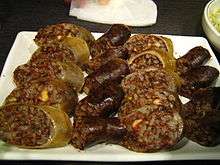
The majority of Korea's sundae (순대) can be categorised as blood sausage. The most common type of sundae is made of sweet potato noodle (dangmyeon), barley, and pig's blood, but some variants contain sesame leaves, green onion, fermented soy paste (doenjang), sweet rice, kimchi, and bean sprouts, in addition to the common ingredients. The Korean sundae is wrapped with pig's intestines. The addition of sweet potato noodle is a more modern addition to the dish. There is another Korean food called seonji which is cow blood that has been boiled in soup. It looks like the Blodpudding of Sweden.
Manchuria and China
In Chinese cuisines, whole coagulated blood is fried or steamed as a snack or cooked in a hot pot. In mainland China, "blood tofu" (Chinese: 血豆腐; pinyin: xuě dòufǔ), or "red tofu" (Chinese: 红豆腐; pinyin: hóng dòufǔ), is most often made with pig's or duck's blood. Like the above dishes, this has no casing but is simply cut into rectangular pieces and cooked. In Northeast China, the "blood sausage" was a traditional food which is cooked with sheep or goat blood. In Tibet, congealed yak's blood is a traditional food.[8][9] Chinese people also used pig blood curd that was consumed by laborers in Kaifeng over 1,000 years ago[10] in the south of China.
Mongolia
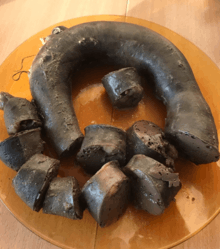
Blood sausage is popular in Mongolia. In Mongolia a special method of killing sheep was made mandatory by Genghis Khan to save blood for sausage. It appears in the Yasa and is still used today.
Taiwan
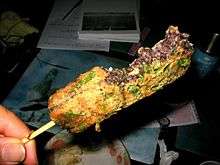
In Taiwan, "pig's blood cake" (Chinese: 豬血糕; pinyin: zhū xuě gāo; Zhuyin Fuhao: ㄓㄨˉ ㄒㄧㄝˇ ㄍㄠˉ) or "rice blood cake"(Chinese: 米血糕; Zhuyin Fuhao: ㄇㄧˇ ㄒㄧㄝˇ ㄍㄠˉ), made of pork blood and sticky rice, is served on a popsicle stick; this is a very popular snack at local night markets.
Tibet
In Tibetan cuisine, sausages or gyurma refer to blood sausages and are made with yak or sheep's blood which may or may not include either rice or roasted barley flour as filler. The sausage uses natural casing employing the use of yak or sheep's intestine.
Southeast Asia
Java
This dish is known in Java as saren, which is made with chicken's blood.
Malaysia
In Penang or other northern states, pig blood curd (known locally in Penang Hokkien as "too huet"; Chinese: 豬血; pinyin: zhū xuè; lit.: 'pig's blood') is usually served with the local street delicacy Curry Mee (curry noodles). It can also be mixed with some traditional Hokkien dishes as well.
Philippines
Blood sausage is known generically as longganisang dugo (lit. "blood longaniza") in the Philippines. A notable type of native blood sausage is pinuneg, which is composed of minced pork and innards in a pork casing made from large intestines that is prepared in the Cordillera Administrative Region of the Philippines.[11][12]
Thailand
In Thai cuisine sai krok lueat (Thai: ไส้กรอกเลือด) is a blood sausage (Thai: sai krok = sausage, Thai: lueat = blood), often served sliced and accompanied by a spicy dipping sauce. "Blood tofu" is simply called lueat (Thai: เลือด, blood) in Thailand. This can be used in many Thai dishes such as in noodle soups, Thai curries, or as an addition to certain rice dishes such as Khao man kai.
Vietnam
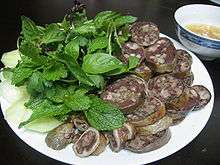
Vietnamese 'dồi tiết' (Northern) or 'dồi huyết' (Southern) is blood sausage, boiled or fried, made with pork blood, pork fat and basil.
South Asia
Europe
Central and Eastern Europe
Throughout Central and Eastern Europe, blood sausage, known as kishka (meaning "intestine"), is made with pig's blood and buckwheat kasha. It is also known in Russia as krovyanka (кровянка), or krovyanaya kolbasa (кровяная колбаса, literally "blood sausage"), and includes buckwheat as a main filler, instead of oats or oatmeal. In Ukraine it's called krov'yanka (кров'янка) or kryvava kyshka (кривава кишка), and kiszka or kaszanka in Poland; krvavnička in Slovakia and krupniok in Silesia. Polish salceson ("black" and "Brunszwicki") are a type of head cheese ("brawn") that contains blood. In Hungary, véres hurka is typically made with pig's blood and barleycorn or cubed bread (typically zsemle) as filler as such also known as zsemlés hurka and gerslis hurka. In Bulgaria, karvavitsa (кървавица) is usually prepared with pig's blood, fat and a variety of mountain herbs and spices and eaten warm during the winter. A similar blood sausage, called krvavica (крвавица), made out of similar ingredients, is also eaten in Bosnia, Croatia, Serbia, and Slovenia in wintertime, usually with sauerkraut and cooked potatoes.
In Romania, the traditional sângerete (from sânge, "blood" in Romanian) is made from shoulder butt pork meat, pork blood and a filler such as pre-boiled rice seasoned with pepper, garlic and basil. It has many regional variants, but the most common are the sângerete from Transylvania.
Similarly, in Czech cuisine, jelito is made from second-rate pork, pig's blood and peeled barley; the stuffing served by itself, unformed, is called prejt.
Northern Europe
Denmark
In Denmark, blodpølse is made from pigs's blood and suet, rye flour, brown sugar, raisins, salt, cinnamon and cardamom stuffed into natural or artificial intestines. It is usually boiled in its skin, eaten hot or cold, sometimes sliced and fried, served with syrup, cinnamon and stewed apples.
Estonia

In Estonia, verivorst (blood sausage) is very similar to Finnish mustamakkara. It is sold and eaten mostly in winter, being a traditional Christmas food. At that time there is a large variety of verivorst in stores, ranging in shapes and sizes. Verivorst is usually cooked in an oven, but sometimes also fried in a pan. Verivorst is often eaten together with lingonberry jam, but occasionally also with butter or sour cream. Another similar dish is called verikäkk (blood dumpling). Its popularity has decreased during the past decades (possibly because of its less appealing commercial appearance) and has mostly been substituted by verivorst.
Finland
Alongside the mustamakkara (black sausage) in Finland, a dish similar to the British black pudding is made by making batter out of pig's blood and baking it like pancakes. Traditionally, rye flour or oatmeal is used and minced onion is added to the mix. This dish is called veriohukainen or verilettu (blood pancake). Rössypottu is a traditional soup in northern Finland with blood pudding as a main ingredient.
Iceland
In Iceland, blóðmör is one of two types of slátur. It is made from lamb's blood and suet, rye flour and oats, traditionally stuffed into pouches sewn from the lamb's stomach. It is usually boiled in its skin, eaten hot or cold, sometimes sliced and fried. After cooking, it is often preserved in fermented whey and acquires a distinct sour taste.
Latvia
In Latvia, blood sausage is either called asinsdesa (blood sausage) or putraimu desa (groat sausage) because of the added barley groats. It usually served with lingonberry jam and sour cream.[15]
Sweden
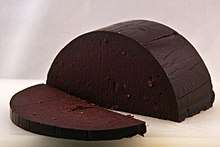
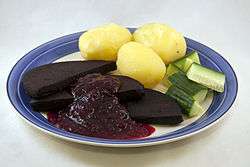
Blodpudding is a traditional medieval dish still popular in Sweden. The exact proportions and ingredients vary, partly according to regional preference, but generally it is made from pig's blood, milk, rye or barley flour, diced lard, either beer or svagdricka, treacle and onion, flavoured with allspice and marjoram. It is then poured into forms and oven-baked in a waterbath. Most of the blodpudding consumed today is made on industrial basis.
When prepared for serving, it is sliced and fried. The style of serving and accompaniments vary across the country, and it is not uncommon to have the blodpudding act as the meat in a meal. Nationally, the common way is to serve it with lingonberry jam, grated carrots and ice cold milk to drink. Fried bacon or pork side is also common. In Scania, the lingonberry jam is often replaced by finely sliced apples, fried along with the pork.
Other blood-based foods include blodkorv (blood sausage) which differs from blodpudding by having raisins, pork tallow and apple sauce in it, blodplättar (blood pancakes, similar to the original Finnish dish veriohukainen above) and blodpalt. There is also a soup made from blood, called svartsoppa (black soup).
Southern Europe
Italy
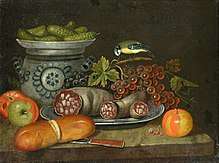
In Italy, regional varieties of blood sausage are known as sanguinaccio. In Tuscany, buristo is a sausage made with pig's blood and fat cooked in a pig's stomach. It is not reheated and is often spread on bread. It is found only in the south of Tuscany in the winter months and even there it can be difficult to come by. Biroldo is another type of black pudding which can be found in Tuscany, while the version made in southern Lombardy is called marsapan.
Migliaccio[16] is a black pudding that is traditionally prepared in winter in Romagna. It is a sweet pudding with a thick black filling made with pig's blood, sugar, breadcrumbs, almonds, chocolate, butter and spices contained in a thin pastry crust. A similar pudding is made throughout southern Italy, generally called sanguinaccio.
Portugal
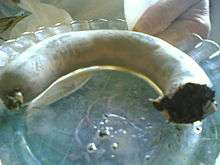
In Portuguese cuisine, there are many varieties of blood sausage. Sausages made of blood are usually called morcela or negrinha (a slang term from Portuguese negro meaning dark or black). There are many varieties around the Portuguese world. There are varieties local to Portugal, the Azores, Hawaii, China, US and India, etc.
Spain
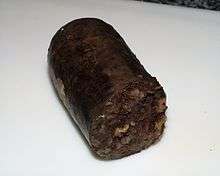
Spanish morcilla has many variants. The most well-known and widespread is morcilla de Burgos which contains mainly pork blood and fat, rice, onions, and salt, and is produced in two varieties: cylindrical and gut-shaped. In Albacete and La Mancha, the morcilla is filled with onions instead of rice, which completely changes the texture. In Extremadura the creamy morcilla patatera includes roughly mashed potatoes. In the northern regions and the Canary Islands there is a sweet variety known as morcilla dulce. Other varieties introduce breadcrumbs, pine nuts, and almonds, and vary the proportions of the other ingredients or flavourings, some of them considered delicacies.
There are other similarly famous kinds being made at Asturias (slightly darker and smaller, used for bean and chickpea stews) and León (without rice, grilled & spread on toasted bread). Other less popular varieties may add cumin to the pudding mixture, but this is not a standard practice. The cooking method for consumption is typically frying, stewing, grilling or roasting, and usually sliced in one-finger-thick wheelettes ("rodajas"). There are many derivative foods made from morcilla, such as omelettes, stuffed red pepper, puff pastry, pizza, flavoured nachos, croquettes, and a range of fillings for different dishes.
Western Europe
Belgium, Netherlands and Luxembourg
In Belgium and the Netherlands, bloedworst or beuling is sold either in 4-inch-diameter (100 mm) slices, or individual sausages the size of a banana. It is generally pan fried; sometimes apples are cooked alongside or on top of the pieces. It is also eaten with apple sauce, brown sugar, syrup or red cabbage. As a cold cut, thin slices are eaten as a sandwich topping. Green cabbage is one of the ingredients in Luxembourg's träipen which are also served pan fried with apple sauce. It is known to have been eaten in church in the Middle Ages during Carnival in the Netherlands . .
France and southern Belgium
In France and Wallonia (south Belgium) boudin noir is traditionally prepared in charcuteries, shops that prepare mainly pork products (and sometimes duck and game), but also sell smoked and dried sausages, pâtés, and terrines, along with prepared salads. It is usually called boudin noir and is often made with cream with apples or onions as a filler. It is generally served with either cooked apples, mashed potatoes or both, and is appreciated by combining either the apples or mashed potatoes with each bite of boudin, which has been gently heated and browned in butter. In France also, there are many different regional Boudins Noirs such as the large Boudin du Béarn with pork meat pieces usually eaten cold. The French Confrérie des Chevaliers du Goûte-Boudin (Brotherhood of the Knights of Blood Sausage Tasting) in Mortagne-au-Perche in southern Normandy holds an annual contest of international blood sausage specialities. Boudin is considered the emblematic staple of the French Foreign Legion, and gives its name to the Legion's anthem.
Germany and Austria
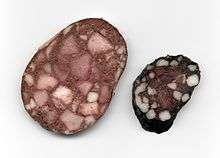
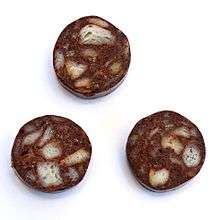
The most common variant of German Blutwurst is made from pork rind, pork blood and regionally different fillers such as barley. Though already cooked and "ready to eat" it is sometimes served warm, similar to the style in France. In the Rhineland, where it is also traditionally made from horse meat, fried Blutwurst is a constituent of various dishes. In particular in Cologne, the traditional Himmel und Erde (Heaven and Earth) combines apple sauce, mashed potatoes and Blutwurst served hot on one plate. In Berlin, hot Blutwurst mixed together with liverwurst and potatoes is called "Tote Oma" ("Dead Grandma").
Other German variants are Zungenwurst, which is Blutwurst mixed with pieces of pickled ox tongue, and Beutelwurst, which is pressed in a linen or paper bag (Beutel). A variety of Blutwurst, the Rotwurst from Thuringia (Thüringer Rotwurst), has geographical indication protection under EU law, with PGI status. Kartoffelwurst (potato sausage) is a post-World War II variety popular in the Palatinate, a reduced fat version of Blutwurst using potato cubes instead of bacon.
In Austria it is often prepared in a dish known as Blunzngröstl, which consists of pan-fried potatoes and blood sausage. This is usually served with freshly grated horseradish.
United Kingdom and Ireland
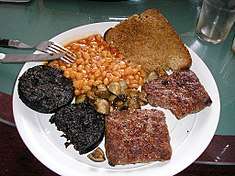
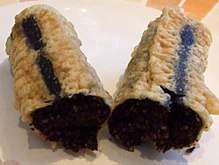
Black pudding is the native British version of blood sausage. It is generally made from pork blood and a relatively high proportion of oatmeal. In the past it was occasionally flavoured with pennyroyal, differing from continental European versions in its relatively limited range of ingredients and reliance on oatmeal and barley instead of onions to absorb the blood.[17] It can be eaten cold, as it is cooked in production, grilled, fried or boiled in its skin. It is often served sliced and fried or grilled as part of a traditional full breakfast, a tradition that followed British and Irish emigrants around the world. Black pudding is now part of the local cuisine of New Zealand and the Canadian provinces of Nova Scotia and Newfoundland and Labrador.
Stornoway Black Pudding produced on the Isle of Lewis, Scotland, is one of the most renowned varieties and has been granted Protected Geographical Indicator of Origin (PGI) status.[18]
The similar white pudding is a further important feature of the traditional Northumbrian, Scottish, Irish and Newfoundland breakfast. Black and white pudding, as well as a third variant, red pudding, is served battered in some chip shops in England, Scotland and Ireland as an alternative to fish and chips.
While "blood sausage" in English is understood in Britain, the term is applied only to foreign usage (e.g., in the story The Name-Day by Saki), or to similar blood-based sausages elsewhere in the world.
Symbol of Carnival
Many Roman-catholics celebrate Mardi Gras, the last day of carnival, (Literally meaning Carne Vale, farewell to Meat in Italian) with rituals involving the blood sausage. For example, in Spain, they celebrate carnival with judías con morcilla (morcilla is a variation of Blood sausage) followed by the funeral of the sardina.[19][20]
Likewise, in Belgium and the Netherlands, the Bloodsausage is a symbol for Carnival. (Most likely following the invasion of Spain during the Eighty Years' War.[21]
François Rabelais in France mentions in his "fourth book" (1552) carnavalesque figures called forest-dwelling Blood-puddings (Saulcis- sons montigènes, Boudins sylvatiques) as a farce representing the Swiss and German protestants.[22]
Additional varieties
Other varieties of blood sausage include blodpølse (Norway and Denmark), tongenworst (with added pigs tongues) (Netherlands), mazzit (Malta), krvavica (Balkans), krovianka (Russia and Ukraine), and vėdarai (Lithuania).
See also
- Blood soup
- Breakfast roll
- Boerewors
- Commonwealth Black Pudding Throwing Championships
- Drisheen
- Full breakfast
- List of sausages
- Red pudding
- Sliced sausage
- White pudding
References
- blood pudding in the Oxford Dictionaries Online
- blood sausage in the Cambridge Advanced Learner's Dictionary
- "A Guide To Traditional Black Pudding". English Breakfast Society. Retrieved 4 November 2019.
- Mutura – The traditional Kenyan sausage by Village Talk accessed on 1 May 2014
- Dave DeWitt & Mary Jane Wilson: Callaloo, Calypso & Carnival, p.62. The Crossing Press 1993
- Ethnic Food Lover's Companion: A Sourcebook for Understanding the Cuisines of the World
- Yucatán: Recipes from a Culinary Expedition, By David Sterling
- Ma Jian, Stick Out Your Tongue Chatto and Windus London, 2006.
- Uses of yak blood in Tibet Archived 1 April 2009 at the Wayback Machine. Retrieved on 9 May 2009.
- Nina Edwards Offal: A Global History Reaktion Books, 2013 p.30-32
- "Longganisa Dugo (Blood Sausage)". Panlasang Pinoy Meaty Recipes. Retrieved 25 March 2019.
- "Baguio eats: Head to this restaurant for a literal taste of blood". ABS-CBN News. Retrieved 25 March 2019.
- Noyoz, The Nepali Times, 18-24 Jan 2013
- Subba, J. (2008) History, Culture and Customs of Sikkim, Gyan, p.133
- "Latgalian recipes: Blood Sausage". Public Broadcasting of Latvia. 14 August 2019. Retrieved 12 August 2019.
- "La scienza in cucina e l'Arte di mangiar bene" by Pellegrino Artusi; recipe n. 702
- Jaine, T. and Davidson, A. The Oxford companion to food, OUP, 2006, p.104
- "Stornoway black pudding given protected status". BBC News, 8 May 2013. Retrieved 15 October 2014.
- https://barcelona-home.com/blog/most-well-known-carnivals-in-costa-brava-region/
- Guitar, Lynne. "The Origins Of Carnival--": 20. Cite journal requires
|journal=(help) - "De Aarde en haar volken - Google Books". Retrieved 21 December 2019.
- "Rabelais's Carnival". Retrieved 21 December 2019.
External links
| Wikimedia Commons has media related to Blood sausages. |
- The Black Pudding. A history and guide by The English Breakfast Society.
- Black pudding recipe from uktv food
